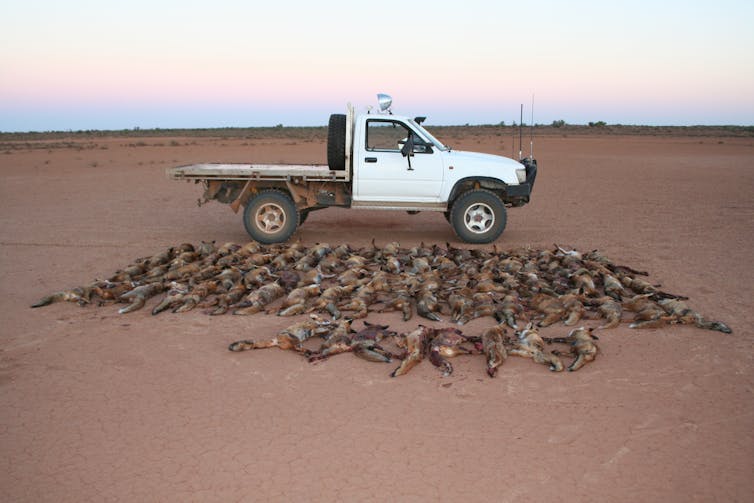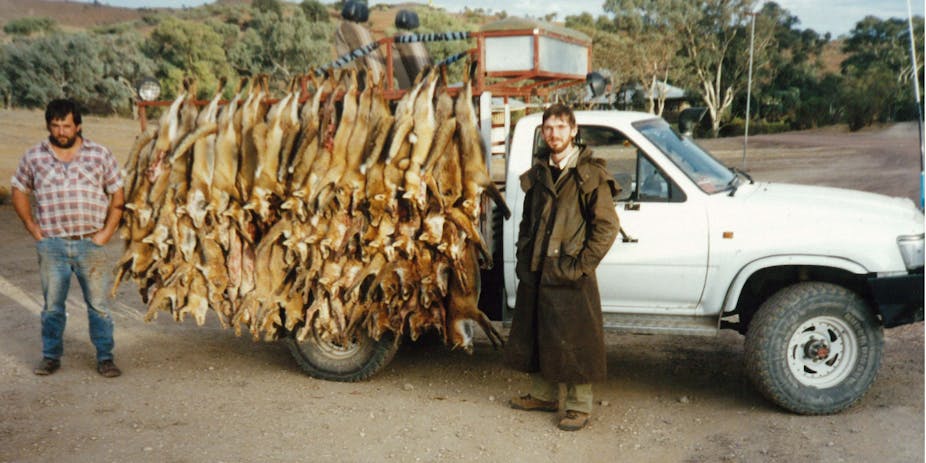The Victorian government has introduced bounties for foxes and wild dogs, $10 for the scalp of a fox, and $50 for that of a dog. Bounties have been tried before, and failed to control these pests, but little has been learnt. In announcing the bounties, benefits to farmers or wildlife figured little; why the program was needed was unclear.
Major tensions were obvious between the politicians and the Victorian government departments which had well-established fox control programs. Publicity about the bounties carried the following advice:
The most effective means of achieving a sustained reduction in fox and wild dog numbers is through simultaneous and coordinated community baiting programs, implemented at a landscape scale and supported by other control techniques. Existing fox and wild dog control programs being conducted on public land will continue during the bounty period.
After the bounty system began, 10,000 fox scalps were returned in the first 11 weeks, meaning that $100,000 or 10% of the annual budget had been spent. One hunter reportedly shot 50 foxes in two days. The monetary return, he reported, “did not recover costs, but it helped.” Scalp collection figures were potentially distorted with a news report proclaiming that “The race is on to scalp and claim Victoria’s $10 bounty on hundreds of fox carcasses hanging from fences”.

The Member for Polwarth, Terry Mulder, said there was a noticeable increase in spotlighting activity across the south west since the introduction of the fox bounty: “Most farmers agree that the bounty is effective at reducing fox numbers” he said. “There are lots of foxes around but some shooters have reported a reduction compared with the same time last year, which is being attributed to the bounty.”
Mulder’s evasive spin was not surprising. Mainland Victoria is 227,000 square kilometres, and fox-density varies seasonally between 1.2 – 3.0 foxes per km2. Applying the latter value over the summer when young foxes are dispersing, the bounties collected represented 1.5% of Victoria’s fox population. How could a mere 1 – 2% change in fox numbers be measured from shooters’ reports alone?
If the annual bonus payment limit of $1 million is reached, which now seems seems likely, only 15–20% of Victorian foxes will have been killed. Furthermore, with four cubs produced by the average vixen next spring, there will be no lasting benefit for lambing percentages or conservation. From the start, the scheme has knowingly been a quack remedy; a palliative rather than a cure.
With Victoria’s politicians so blatantly diverting funds better spent on conservation or agricultural protection into shooter’s pockets to gain favour, we must seriously question their ability and motives in general when they speak of opening up National Parks to recreational shooting for pest control.
In some areas, shooting can contribute to conservation. For example, South Australian Sporting Shooters have contributed time and skills to fox control in the Flinders Ranges National Park but that has been done as part of a wider program, mopping up those few foxes and feral cats left after baiting campaigns. Even then, spotlighting for long hours on cold nights soon wears thin and the shooters need to re-kindle their enthusiasm by occasionally visiting other locations where there are more foxes to shoot.
It is also important to note that when brush-tailed bettongs were re-introduced into that park, they eventually succumbed to cats and foxes despite intensive predator control efforts. Clearly, an extremely high level of control must be maintained if re-introductions are to succeed. But having a few hunters wandering about in National Parks randomly shooting the odd feral animal does not constitute effective control. We need to know the level of predator reduction required and make sure combined control efforts meet those goals. This cannot be decided by politicians who demonstrably lack any understanding of what pest control means.
I have recently visited several nature reserves where programs are in place to control feral goats, but Gluepot Reserve, BirdLife Australia’s sanctuary in South Australia’s Riverland, stands out for its achievements. The key to success on the former sheep station has been the filling-in of dams using a bull-dozer; the few dams left to supply water for fire-fighting and domestic use have been fenced off, leaving the goats little option but to move elsewhere. Shooting is important too, but again, this is carefully used with radio-collared “Judas goats” to locate the few remnant goats. Gluepot’s lack of goats compared with surrounding areas proves that there are much better alternatives than relying on shooting alone.
Together with other methods, well-organised shooting can play a useful role in pest control and conservation programs. But as for recreational shooting to remedy persistent feral animal problems - forget it! Even when subsidised with bounties shooting by itself cannot work. So why promote and fund it when there are much better, well-proven ways of doing things?
Comments welcome below.

